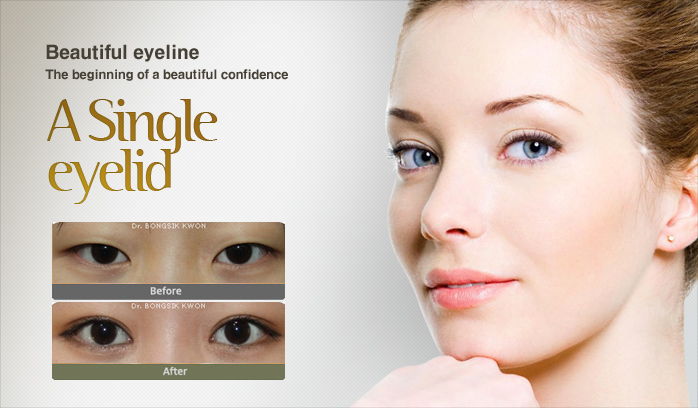
01Difference of eyes among races/ Ethnicities

Anthropologists call Asians as 'Mongoloids’. There is the anthropological hypothesis that the single eyelid is a outward phenotype which is the result of evolution for adaptation to relavant environments. Genetically, All modern humans are included into the subspecies Homo sapiens sapiens, i.e. the subspecies of Homo sapiens. According to the results of various analyses, Koreans are classified as part of the northern Mongoloid race and the southern Mongoloid race. Except for the southeast Asian and part of Chinese race, people of Korea, Manchuria, and north of part of the Great Wall of China are named as ‘a northern mongoloid’ and has characteristics such as small eyes without a double eyelid, epicanthus, a flat face with prominent cheekbones, and a mongolian spot on the buttocks. On the other hand, the southern Mongoloid race adapt to relatively warm climates in areas such as Polynesia, and Hawaii in the Pacific ocean. Most people from the oceanic regions and southern Asia have incomplete double eyelids, slight epicanthus, and bigger eyes than the people of the northern regions. They are called the 'southern mongoloids’. It is said that among Koreans, 70~80% of the people are north and 20~30% are the south. It has been reasoned that the racial differences of modern humans are just phenotypic variations. But, the developmental mechanism of Asian single eyelid was not suggested clearly. We reconsidered basically without stereotype for the Asian eyelid. Dr. Kwon suggests that the Asian epicanthus and single eyelid has developed in evolutional process of eyelid(Kwon’s Theory).
02Actual shape and differences of eyelid in Asians
Actual shape of eyelid and canthus
Examples) In most Asian single eyelid, eyes with a single eyelid seem so small in both of width and length, they look stuffy and puffy. Therefore, the refined image is hardly made and they always cause the eyes to look swollen and small as if the person is unintentionally glaring.

The eyelashes are the true boundaries of the palpebral fissure. The eyelashes of a Caucasian is exposed completely and the eyes look clear. Also, the eye looks bigger with the parallel supratarsal crease of eyelid. In contrast, the eye of Asian without supratarsal crease is veiled by various amount of skin drooping and the eyeline where the lashes grow is hidden beneath the soft tissues called epiblepharon. The more the eyelid tissues droops down, the smaller and the puffier the eyes look.
Example) Caucasian's canthal angle

Example) This picture shows a case of asymmetric shapes of the canthal angles and caruncles(the red tissue at inner corner)
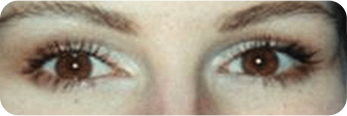
The canthus of Caucasian is exposed completely, whereas the inner part of medial canthus of Asian eye is veiled by the epicanthus. The shapes of the canthal angle are quite various, but generally Asian canthal angles are rounder and shorter than those of the Caucasians. There are various distortions of canthal shape in Asian medial canthus which have been affected in the eyelid evolution. Devolutional epicanthoplasty can restore original shape of medial canthus and reveal it completely. Epicanthoplasty also restore length of palphebral fissure and refine nasocanthal contour.
Examples) Magic epicanthoplasty combined with a non- incisional double eyelid surgery

Examples) Double eyelid surgery, ptosis correction with epicanthoplasty. Notice minimal epicanthus before epicanthoplasty.

Anatomical differences of eyelid between Caucasian and Asian
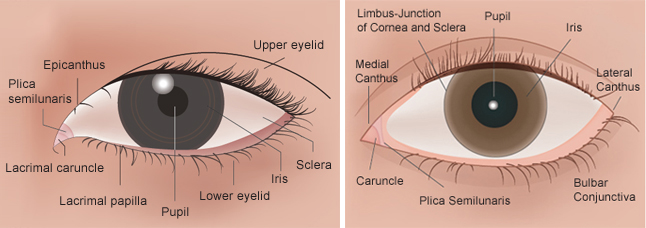
Anatomical charicteristics of Asian upper eyelid :
Thick, streched skin
Subcutaneous fat
Preseptal/pretarsal fat
Thickened, malpositioned orbicularis muscle
Lax, ballooned septum with lower insertion with levator aponeurosis
Prolapsed, hypertrophied preaponeurotic fat pad with incompentant septum
Weak, incomplete anterior expansions of the levator aponeurosis.
Stretched, weakened levator aponeurosis and Muller muscle
Smaller vertical height of tarsal plate
Although the eyelid is very thin, various tissues (skin, orbicularis muscle,septum,levator muscle, Muller muscle, tarsal plate, fat, conjunctiva) are composed in it. The levator muscle and mullermuscle are those that help open the eyes. In Caucasian, the levator aponeurosis is usually attached to the tarsus and skin of inferior part of eyelid . The strands of the muscle tissues (levator expansion) are attached to the back of the skin of the eyelid, and the skin attached is pulled during eye opening, then a double eyelid is formed. The fusional part of the orbital septum and levator aponeurosis in Caucasian eyelid is typically in the skin crease (8-12 mm from eyelid margin). Its location lies above the superior tarsal border(2-5mm), which limit the downward prolapse of the orbital fat pads and enable aponeurotic expansions to insert toward the subdermal surface of the pretarsal eyelid skin. Whereas the fusional part lies at the lower point in Asian eyelid and the height of tarsal plate is relatively less than Caucasian’s(more than 8mm in Caucasian). Because of the differences in the eyelid anatomy of Asians, the surgical methods ususally applied to Caucasian cases cannot yield the favorable result in Asian blepharoplasty. Considering the differences of the Asian eyelid and relationship of the epicanthus and double eyelid, structural Asian blepharoplasty based on devolutional concept should be applied to establish a appropriate plan and accomplish best results. The devolutional Asian blepharoplasty can yield much better, natural looking surgical results because it is basically different from conventional blepharoplasty based on Caucasian’s eyelid anatomy
For Asian blepharoplasty, the upper eyelid should be evaluated for :
Epicanthus and epiblepharon with/without orbicularis muscle
malposition
Existence or absence of crease
Excess and thickness of skin
Amount of preaponeurotic fat,usually pseudoherniated and hypertrophied
Blepharoptosis
Pericanthal skin tension
Shape of medial canthus
Brow ptosis and lacrimal gland ptosis
Inclination between medial canthus and lateral canthus
Eyelash direction and prickling around medial canthus
Skin fold on lower eyelid and related wrinkles
03What is a single eyelid of Asian?
Asian single eyelid (monolid)
Examples)An Asian Eye with a single eyelid
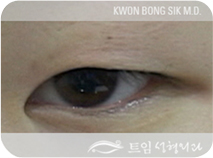
Examples)An Asian Eye with a inout type double eyelid
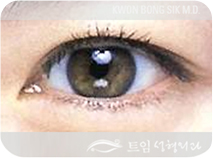
Examples) Combined epicanthoplasty and non-incisional double eyelid surgery

We call the Asian eye without a double eyelid as a single eyelid or monolid. An eyeline where the eyelashes grow is covered with drooping skin. As a result, the eye seems small and puffy.In an eye with double eyelid, the levator muscle holds the skin and the skin is pulled as people open their eyes and forms a double eyelid. While in Asian eye without double eyelid, most have no connection between the levator muscle and the skin. There are thick fibrous tissue and malpositioned orbicularis muscle which block pulling the skin. The fibrous tissues and malpositioned orbicularis muscle within epicanthus and epiblepharon prevent even transmission of levator muscle power toward the medial skin because the aponeurotic fibers have been detached and do not extend to the epicanthal skin area any more.
Examples) A Caucasian Eye with supratarsal crease

Caucasians, unlike the eyes of Asians, have no epicanthus. Instead, they have a double eyelid in shape of out-fold (semilunar type), and the eyeline is exposed completely from the inner corner of the eyes. That is the reason why their eyes seem refined, more open, and vivid. This is merely a racial difference. However, the single eyelidis not to be thought as strange or unusual because thisis the usual and dominant structure for Asians or other related races. Although single eyelid is not medical issue, the surgery may be needed in order to enhance the beauty of Asian eyes.Asian double eyelid surgery should reform not only the connection between levator muscle and skin, but also should resolve the epicanthus and epiblepharon. Then, we can finally create anatomical crease and beautiful eyes.Asian blepharoplasty is done by removing excessive soft tissues, repositioning tissues, and folding the skin with further exposing the rest of your pupil/iris and giveAsian eyes a brighter, more natural look.
Examples)Structural Asian Blepharoplasty combined with the magic epicanthoplasty and double eyelid surgery
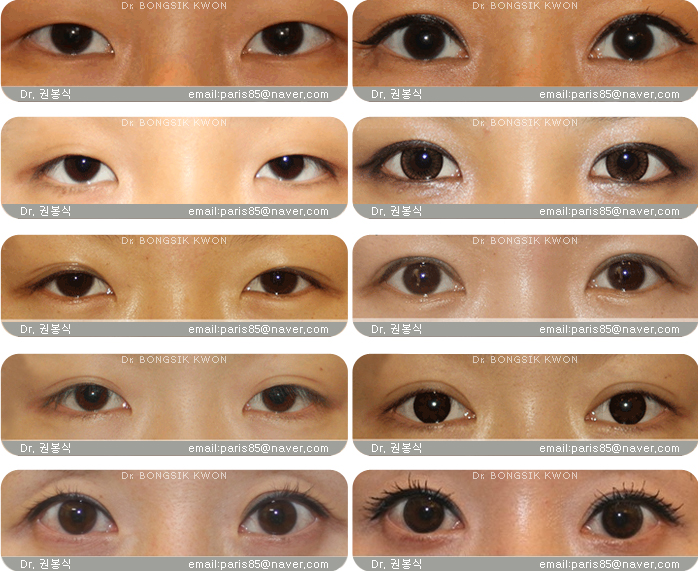
Examples) This is a case of an inner double eyelid. After combination surgery of magic epicanthoplasty and double eyelid surgery, they show distinctive eyelines and refined general shapes.

Functional aspect of a single eyelid
The eye of Asian without supratarsal crease is veiled by various amount of skin drooping and the eyeline where the lashes grow is hidden beneath the soft tissues called epiblepharon. The more the eyelid tissues droops down, the smaller and the puffier the eyes look. A single eyelid of Asians is likely to cover the iris and pupil partially. When skin drooping is severe, eyelashes can prickle the cornea and it can cause problem of visual acuity . In this case, a double eyelid surgery removing parts of the drooping eyelid , forming a double eyelid and extending exposure of pupil, will brighten the patients’ vision. Therefore, a double eyelid surgery has a positive effect to get a better vision for the basic function of the eyes. After double eyelid surgery, the eyes look more clear and bright.
Examples) An excisional double eyelid surgery has an beneficial effect on providing a better vision (exposure of pupil)

Examples) Forming a clear double eyelid and more exposure of pupil by ptosis correction and revisional double eyelid surgery

Examples) Forming an inner type of double eyelid and increased exposure of pupil by ptosis correction and a double eyelid surgery.

Examples) Forming an parallel type of double eyelid and increased exposure of pupil by ptosis correction and double eyelid surgery.

04Reasons why Asian have single eyelids
Racial/Ethnic reasons
Anatomical reasons

Sayoc’s Theory
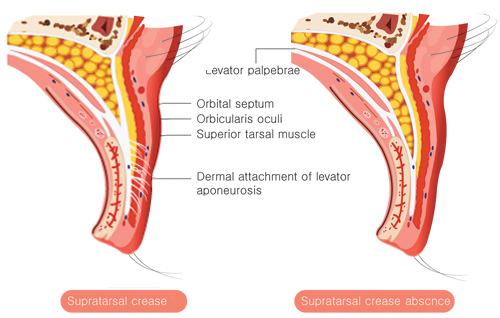
However, the electron microscopic studies confirmed that levator aponeurotic fibers penetrate the orbicularis muscle in both single and double eyelids of Asian, of course Caucasian. This finding suggested that Sayoc’s theory of the “levator expansion” had been incorrect.
Kwon’s Theory
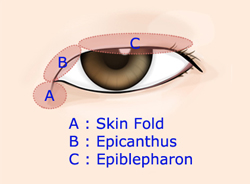
If so, why does the supratarsal crease not exist although aponeurotic fibers do penetrate the orbicularis muscle in Asian single eyelid? Dr. Kwon reconsidered basically without stereotype for previous theory about Asian double eyelid and the epicanthus from 2005, because Sayoc’s theory could not explain absence of Asian double eyelid and presence of epicanthus clearly. Dr. Kwon’s research tried to address the formative causes of epicanthal deformity and loss of double eyelid at the same time in evolutional aspect. Dr. Kwon’s research concluded that the answer for Asian double eyelid is not “not previously existed” but “lost” during evolution. Environmental adaptation is the basic cause for loss of supratarsal crease and formation of the epicanthus. Genetically, all modern humans are included into the subspeciesHomo sapiens sapiens,i.e. the subspecies of Homo sapiens. It has been reasoned that the racial differences of modern humans are just phenotypic variations. The stereotype of Sayoc’s theory may mislead plastic surgeons to misunderstand Asian double eyelid and epicanthus incorrectly. So, the evolutionary approach to Asian epicanthus or absence of supratarsal crease has not been researched and not suggested ever. Dr. Kwon suggested Kwon'stheory for the evolution of Asian eyelid.

Loss of medial crease, formation of the epicanthus, loss of mid-lateral crease, formation of the epiblepharon occur in sequence.
I. Stage of hypertrophy: The hypertrophy of orbicularis oculi muscle and depressor supercilli muscle develop by repeated frowning. The hypertrophy of orbicularis oculi muscle cause attenuation of the aponeurotic expansion which penetrate through orbicularis muscle. The aponeurotic penetrations
loosen and become sparse.
II. Stage of sheer stress: Complete detachment of aponeurotic expansions with loss of supratarsal crease takes place on point S by sheer stress. The detachment of aponeurotic fibers can occur beneath the orbicularis muscle or on the orbicularis muscle. Orbicularis oculi muscle contraction acts as sheer tensional stress with depressor supercilli muscle. The depressor supercilli muscle plays an ancillary role.
III. Stage of tensional stress: The successive loss of medial crease below point S results from displacement of preseptal orbicularis oculi muscle toward eyelash and the vicious cycle between malpositioned muscle hypertrophy and crease loss. The orbicularis oculi muscle contraction mainly act as tensional stress on remaining aponeurotic fibers and medial crease.
IV. Stage of compressional stress: Excessive contraction of orbicularis oculi muscle acts as compressional stress on overlying skin of upper medial eyelid with resultant vertical skin shortage and tension. The tight tension band develops due to vertical skin shortening of upper medial eyelid.
V. Stage of traction and tensional stress: Contraction of orbicularis oculi muscle acts as tensional stress on remaining supratarsal crease resulting in successive loss of supratarsal crease on the upper eyelid superiorly and/or act as traction force causing skin tent toward point P on the lower eyelid inferiorly. During and after formation of a tight tension band by vertical skin shortage, the orbicularis oculi muscle contraction causes a prominent skin fold on the lower eyelid by pulling-up the muscle point of origin like setting up a tent pole during contraction. The preseptal orbicularis muscle pulled up its origin superolaterally with skin tent on lower eyelid during contraction.
VI. Stage of degeneration: The atrophy of orbicularis oculi muscle and accompanying degenerative fibrosis develop, leaving the epicanthus with incomplete crease or epicanthus without crease.
The hypertrophied orbicularis oculi muscle becomes atrophied and replaced by fibrosis, but there remains vertical skin shortage and tension left on upper eyelid and skin fold and wrinkles on lower eyelid. Also there has been left centripetal fibrosis toward point p under the skin of lower eyelid.

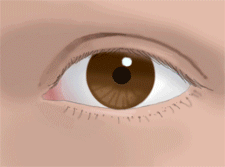
Increased blood supply induced by hypertrophied orbicularis muscle and climate factors would cause hypertrophy and pseudoherniation of preaponeurotic fat. Displacement of orbicularis muscle and fat pad would affect the levator muscle and Muller’s muscle. A relatively longer medial canthal ligament and underdeveloped nasal bone would be additional evolutional manifestations by hypertrophy of the orbicularis oculi and excessive tension.
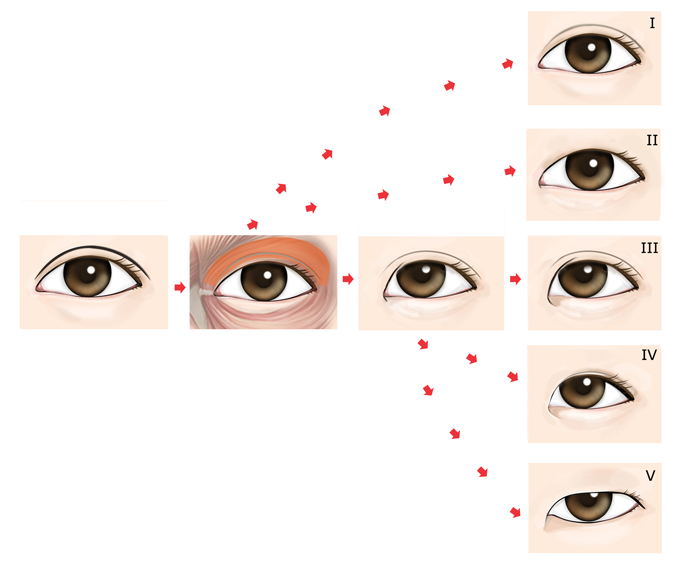
Type I : Attenuated original crease without epicanthus (exopthalmic Asian eyelid)
Type II : Minimal epicanthus without crease. (without epibepharon)
Type III : Epicanthus with attenuated original crease
Type IV : Epicanthus with lowered infold crease
Type V : Epicanthus without crease (epicanthus and epiblepharon).
Examples) Only a double eyelid surgery performed with severe epicanthus. They look fierce .

Examples) Structural double eyelid surgery combined with magic epicanthoplasty.


Examples) Structural double eyelid surgery combined with magic epicanthoplasty for bigger and parallel type double eyelid.

Examples) Revisional double eyelid surgery combined with Magic epicanthoplasty.
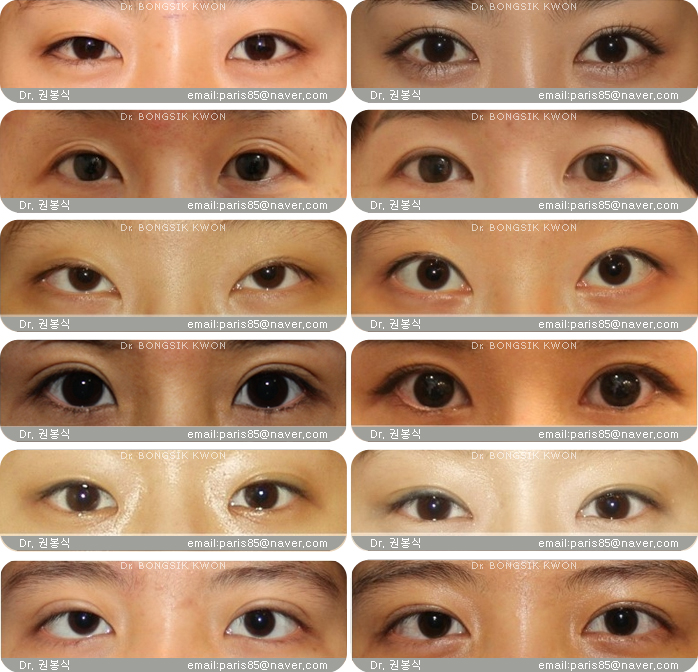
05Various types of single eyelids or incomplete double eyelid in Asian
A single eyelid with severe epicanthus (true epiblepharon)
Examples) A single eyelid covering the pupil by the excessive skin drooping.

Examples) Partial incisional double eyelid surgery combined with magic epicanthoplasty.

Examples) Incisional double eyelid surgery combined with magic epicanthoplasty.

Examples) Incisional double eyelid surgery combined with magic epicanthoplasty.

A single eyelid that shows an incomplete wrinkle line
Examples) Non-incisional double eyelid surgery (buried suture method) combined with Magic epicanthoplasty
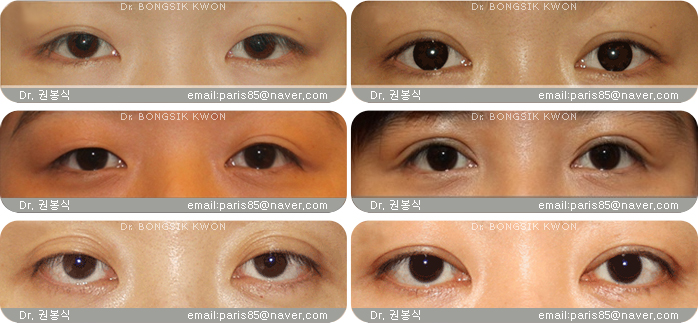
An incomplete double eyelid using liquid glue or adhesives
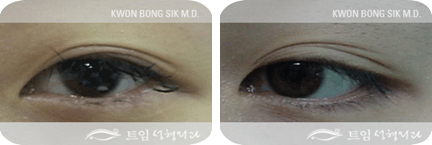
Examples) Double eyelid surgery combined with Magic epicanthoplasty in eyes with incomplete double eyelid lines

A single eyelid crumpled at thin skin
Examples) Non-incisional double eyelid surgery combined with Magic epicanthoplasty in thin skin type eyelids

A single eyelid with visible eyeline in thin skin (minimal epicanthus and minimal epiblepharon)
Examples) Non-incisional double eyelid surgery combined with Magic epicanthoplasty and lateral canthoplasty.

Examples) Non-incisional double eyelid surgery in thin skin type eyelids

Cases where the eyes get poked by your own lashes (Inversion)
Examples) Direction of eyelashes of a Westerner

Examples)double eyelid surgeryin the patient with prickling

Examples)Structural double eyelid surgeries combined with magic epicanthoplasty in the patients with prickling










